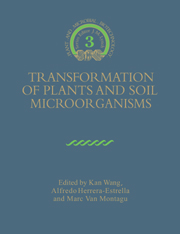Book contents
- Frontmatter
- Contents
- List of Contributors
- Series Preface
- Preface
- Acknowledgements
- Abbreviations and Terms
- Part I Transformation of Soil Microorganisms
- 1 Pseudomonas
- 2 Nocardioform and Coryneform Bacteria
- 3 Agrobacterium, Rhizobium, and Other Gram-Negative Soil Bacteria
- 4 Filamentous Fungi
- Part II Transformation of Cereal Crops
- Part III Transformation of Industrially Important Crops
- Index
3 - Agrobacterium, Rhizobium, and Other Gram-Negative Soil Bacteria
Published online by Cambridge University Press: 04 August 2010
- Frontmatter
- Contents
- List of Contributors
- Series Preface
- Preface
- Acknowledgements
- Abbreviations and Terms
- Part I Transformation of Soil Microorganisms
- 1 Pseudomonas
- 2 Nocardioform and Coryneform Bacteria
- 3 Agrobacterium, Rhizobium, and Other Gram-Negative Soil Bacteria
- 4 Filamentous Fungi
- Part II Transformation of Cereal Crops
- Part III Transformation of Industrially Important Crops
- Index
Summary
Introduction
The introduction of DNA into bacterial cells is essential for rapid genetic analysis, i.e., mapping, complementation analysis, and as a tool for introduction of plasmids that contain cloned fragments. Several different approaches are used with Gram-negative soil bacteria, including transformation (natural and electroporation assisted), transduction and conjugation. Protoplast fusion has not been successful in Gram-negative bacteria. Of all the procedures for DNA introduction, transformation is the most frequently used owing to the advent of gene cloning and the need to introduce plasmids (with cloned inserts) into bacteria. In this respect, introduction of plasmids is important for complementation analysis, generation of clone banks, integration of DNA sequences into the genome by recombination, and introduction of a desired gene into a cell on a stably maintained plasmid. Only a limited number of bacterial species permit natural transformation (e.g. Haemophilus influenzae, Streptococcus pneumonia, Bacillus subtilis and Acinetobacter calcoaceticus), but several bacteria have become amenable to transformation after treatment with special chemicals and/or heat cycles (Escherichia coli, Rhizobium, Agrobacterium, and Bacillus cereus). More recently, a wide variety of bacteria have become transformable by the application of high electric currents, which causes membrane permeability, allowing uptake of large DNA molecules. This process, termed electroporation, has had a dramatic impact on the ability to insert any desired DNA sequence into any bacterial species.
The genera Rhizobium, Bradyrhizobium and Agrobacterium are economically important soil bacteria; Rhizobium and Bradyrhizobium fix nitrogen in symbiosis with the family Leguminosae, and Agrobacterium, besides causing plant diseases, is used as a vector system for introduction of foreign DNA into dicotyledonous plants.
- Type
- Chapter
- Information
- Transformation of Plants and Soil Microorganisms , pp. 23 - 33Publisher: Cambridge University PressPrint publication year: 1995
- 1
- Cited by



